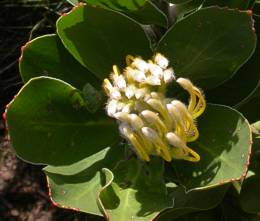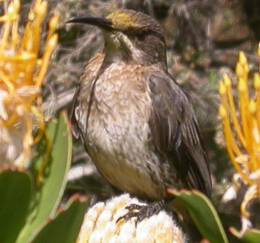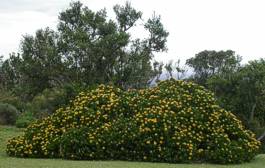Leucospermum conocarpodendron subsp. viridum
Leucospermum conocarpodendron (L.) H.Buek subsp. viridum
Family: Proteaceae
Common names: green tree pincushion, hairless tree pincushion, yellow pincushion (Eng.); groenkreupelhout, kreupelboom, goudboom, brandhoutboom (Afr.) (Previously known as Leucospermum conocarpum)
SA Tree No: 84.1
Introduction
The largest of the pincushion group of proteas, the green tree pincushion is absolutely spectacular when in flower. The large rounded bushes are then covered with bright yellow pincushion flowers which glow among the deep green leaves and are further decorated by the antics of the Cape Sugarbirds which feast on the plentiful nectar.

Description
Description
Although more shrub-like than tree-like, this species — because the plant has a single trunk and grows up to 5 m tall and 6 m across — has been given tree status. The trunk, which may reach 400 mm in diameter, has corky bark up to 50 mm thick and the mature branches have a dense covering of hairs.

The leaves are deep green and smooth when mature, although sometimes with a slightly hairy fringe on the edges. They vary in shape and the tips may be pointed or rounded with 3-10 reddish glandular teeth, 60-115 mm long and 25-50 mm wide; they are stalkless and closely packed along the branches. (In autumn young leaves are covered in grey hairs, which may cause identification difficulties between the two subspecies, as Leucospermum conocarpodendron subsp. conocarpodendron, the grey tree pincushion, retains a constant covering of grey hairs throughout the year.)
The flower heads are often borne in groups of 3 and each is 70-90 mm across. Each globose to ovoid flower head bears a large number of flowers closely packed together to form the 'pincushion'. Because all the flowers are so tightly packed together the whole compound flower head is often mistakenly called the flower. These flowers are not made up of the usual petals and sepals with which we are familiar when speaking about flowers; rather, each flower is made up of 4 outer floral parts called the perianth, which in this species is coloured yellow. (Collectively these are the parts that form the 'cushion' portion of the flower head.) The conspicuous style or 'pin', which ends in a 'pollen presenter', is released from the perianth to which the anthers are attached. As the style bearing the stigma uncurls from the perianth it passes the anthers and collects the pollen on the pollen presenter, from where the pollen is easily rubbed off onto bird pollinators such as the Cape Sugarbird.
The green tree pincushion flowers from August to December, releasing its seeds 1 or 2 months after flowering. The seed is a hard ovoid nut which is covered by a white elaiosome, a nutritious attachment which is very attractive to ants.
Conservation Status
Status
Near threatened (NT). It has lost an estimated 24% of its habitat over the past 60 years, due to agricultural and urban expansion, afforestation and alien plant invasion.
Distribution and habitat
Distribution description
This species occurs on the Cape Peninsula, then eastward across the Cape Flats (where it has been largely decimated by development) to the Hottentots-Holland, Franschhoek and Kogelberg mountains, and then on to Kleinmond and further east to Stanford. It grows mainly in the lowlands on well drained, sandstone-derived soils, often in fairly dense stands.
Derivation of name and historical aspects
History
The genus Leucospermum comprises 48 species, most of which grow in the fynbos of the south-western Cape. A number of species do however occur further afield in the southern and eastern Cape as well as Kwa-Zulu Natal and Zimbabwe.
Leucospermum is derived from the Greek words leukos meaning white, and sperma meaning seed. A fleshy, white covering called the elaiosome surrounds the seed of Leucospermum species. Conocarpodendron means 'the tree bearing cone-shaped fruits'. Viridum refers to the green colour of the leaves.
This was the very first pincushion species in the genus Leucospermum of the Protea family to be described in writing. This is not surprising as it was common all over the Cape Peninsula and farther afield, large and very striking when covered with masses of bright yellow flowers. In about 1700 this species was first cultivated in Holland. In 1710 it was intoduce into England by Masson, who collected plants in South Africa for the Royal Botanic Gardens at Kew,
The name kreupelhout was already in use before 1680 and refers to the bent branches which give the tree a crippled appearance. The leaves of this subspecies are a rich deep green which is the reason for it having the colour green or groen added to some of the common names, unlike the other subspecies which is grey-leaved. When yellow or goud are included in the common name this alludes to the flower colour, which is a brilliant yellow. Brandhoutboom, a name no longer in use, alludes to the fact that it was used extensively for fuel purposes.
The other subspecies, Leucospermum conocarpodendron subsp. conocarpodendron, the grey tree pincushion, has a much smaller distribution than Leucospermum conocarpodendron subsp. viridum, being confined to the granite-derived soils in the north-western part of the Cape Peninsula. Also, by contrast, the leaves are not green but grey and very hairy.
Ecology
Ecology
Large specimens of green tree pincushions may be somewhat fire-resistant because of their thick bark, but because fires in some areas have occurred too frequently there are not as many plants in natural areas as there were previously. Development has also reduced many populations. The biggest trees, which may rarely reach heights of 5-6 m, are usually found in sheltered areas where they are protected from fire and strong winds. The lower branches generally droop, so that the tree has a mounded shape which helps prevent wind damage, the wind being deflected over the tree instead of battering it to pieces.
Cape Sugarbirds are the main pollinators of these plants, which provide a good food resource for them. The plentiful nectar supply also attracts a variety of insects so that the birds can feed not only on nectar but on insects too. Bird-ringers wanting to monitor sugarbird populations will often put up their mist nets in the vicinity of flowering green tree pincushions.

Bees and wasps also play a role in pollination. Ants are attracted to the nutritious fleshy envelope, called an elaiosome, which surrounds the hard nut-like seed. Many species of ant aid in the dispersal of the seeds by carrying them to their nests where they feed on the elaiosome leaving the seed safely buried there. When conditions are favourable, usually after a fire, the seed will germinate in response to various cues they receive from the environment.
On Little Lion's Head on the Cape Peninsula an interesting population can be seen where this subspecies has hybridized with its fellow subspecies, L. conocarpodendron subsp. conocarpodendron.
Uses
Use
Many of the pincushions are sought after as cut flowers or garden subjects and are readily available in nurseries. Many hybrids have been developed by crossing species and these contribute to the economies of several countries around the world, e.g. Australia, New Zealand and Zimbabwe as well as their homeland, South Africa.
The green tree pincushion is used as a cut flower, but is not as popular as some of the other pincushion species or hybrids as the stems tend to be short, thick and crooked. This makes for interesting flower arrangements but means it is not really suitable for packing into flower boxes for transporting. The yellow colour is however superb in an arrangement.
It is used successfully as an intergeneric rootstock for grafting various Mimetes species which also belong to the Protea family. The Mimetes species are very susceptible to root diseases, while the green tree pincushion is much less so. This grafting process has meant that some of the rare and/or threatened Mimetes species can be successfully grown outside of their usual habitats, thus helping to conserve them.
The reddish wood is soft, but tough, with beautiful netlike markings and was extensively used as firewood and made into excellent charcoal in colonial times. As one of the larger plants in the natural vegetation, with relatively big branches and trunks, it was more worthwhile to cut and burn than many of the smaller, thinner plants in the fynbos. The bark was considered one of the best for tanning, and large quantities were harvested. These uses meant that enormous quantities of these trees were cut out and the numbers of especially the big specimens were severely reduced. The wood was sometimes used to make the felloes for ox wagon wheels. Peter Kolbe(n), in one of the earliest books on the natural history of the Cape published in 1719, recorded that a decoction made from the bark was used as a remedy for dysentery.

Growing Leucospermum conocarpodendron subsp. viridum
Grow
This is an excellent plant for seaside gardens along the winter-rainfall western and southern Cape coasts, since it is resistant to wind and salt spray, is well-suited to poor sandy soils, and provides wonderful spring and early summer colour. It can be planted at the back of borders where it can be allowed to grow to its full size, although this rarely happens in a cultivated garden. Planted about 1.5-2 m apart it would make a useful hedge. It looks best when interplanted with other fynbos species with the same water requirements. Plant at least one of these pincushions if you want to attract Cape Sugarbirds to your garden.
Full sun and good drainage are essential and the plant should not be grown in areas which receive frost.
Seeds can be collected 1-2 months after flowering (remember you are competing with the ants which also collect the seeds!) and the elaisome is soaked in hot water and then rubbed off. Cleaned dry seeds are stored in a cool dry place until needed for sowing in March or April. Before sowing, soak the seeds in Kirstenbosch Smoke-Plus seed primer for 24 hours. If this smoke primer is unavailable soak the seeds in a 1% hydrogen peroxide solution. A well-draining, but moisture-retaining mixture of 10 parts river sand, 6 parts loam soil and 7 parts of finely milled bark is tamped down into a deep sowing tray. Some of the above mixture is put through a fine sieve and used as a thin top layer to lightly cover the seeds which have been scattered on the base layer.
Place the trays in a greenhouse and water sufficiently to keep the soil medium moist but under no circumstances allow them to become waterlogged or to dry out. Seeds take about 4 weeks to germinate and should be pricked out into 500 ml bags containing the same mix as above when they are about 15 mm tall and have developed their first pair of true leaves. Allow to harden off under light shade cloth for 3-4 weeks, then place them in full sun.
Feed on a monthly basis with a fish emulsion fertilizer at recommended strength. Other nitrogenous fertilizers may be used but avoid any of those containing phosphates. In about 6 months the plants should be about 200 mm high and should be ready to plant into their permanent positions.
These should be sunny and well-drained. Do not use manure or commercial fertilizers in the planting holes, which should be square and about 25 cm deep. Well-matured compost mixed 50/50 with the soil will give the plants a good start. For the first two years after planting out, the young plants should receive water regularly especially in summer or during dry periods. Mulching is useful for retaining water and suppressing weed growth.
Take disease-free cuttings between November and April from vertically growing shoots which are firm. Cut off, not strip, the leaves from the lower third of the cuttings. Dip the base into a rooting solution or powder and root in a deep tray or preferably in a perforated plastic sleeve or multi-tray filled with the same mixture as for seed sowing. Place under mist on a bottom heated bench (22-25°C). Rooting should take place in about 8-12 weeks and the plants are then potted into bags as for the seedlings above. Treat with fungicide on a regular basis.
Cuttings and seedlings are susceptible to aphids when young and should be sprayed with an appropriate insecticide. Rust and leaf miners are also occasionally problematic and should be sprayed as necessary. Mature plants may succumb to the root fungus Phytophtora cinnamomi. The best method of preventing this is to make sure the plants are not water-stressed, and good drainage and free air movement round the plants are essential.
References
- BEAN, A. & JOHNS, A. 2005. Stellenbosch to Hermanus. South African Wildflower Guide 5. Botanical Society of South Africa.
- BROWN, N, KOTZE, D. & BOTHA, P. 1998. Grow Proteas. Kirstenbosch Gardening Series, National Botanical Institute, Cape Town.
- ELIOVSON, S. 1965. Proteas for Pleasure. How to grow and identify them. Howard Timmins, Cape Town.
- GERMISHUIZEN, G., MEYER, N.L., STEENKAMP, Y. & KEITH, M. (eds). 2006. A checklist of South African plants. Southern African Botanical Diversity Network Report No. 41. SABONET, Pretoria.
- JACKSON, W.P.U. 1990. Origins and meanings of names of South African plant genera. UCT Ecolab, Botany Dept.
- KESTING, D. (compiler) 2001. Wild Flowers of the Cape Peninsula. Botanical names: Origin and meaning. Flora Documentation Project, Friends of the Silvermine Nature Area, St James.
- LEISTNER, O.A. (ed.) 2000. Seed plants of southern Africa : families and genera. Strelitzia 10. National Botanical Institute, Pretoria.
- MATTHEWS, L. 1993. The Protea growers handbook including Leucadendrons, Banksias and Grevilleas. Bok Books International. Trade Winds Press, Durban.
- Palmer, E. & PITMAN, N. 1972. Trees of Southern Africa, Volume 1. A.A. Balkema, Cape Town.
- REBELO, T. 1995. Sasol Proteas: a field guide to the Proteas of Southern Africa. Fernwood Press, Vlaeberg.
- REBELO, T. 2000. Field guide to the Proteas of the Cape Peninsula. Protea Atlas Project, National Botanical Institute, Cape Town.
- SMITH, C.A., 1966, Common names of South African plants. Botanical Survey Memoir No. 35.
- VAN WYK, B. & VAN WYK, P. 1997. Field guide to trees of Southern Africa. Struik Publishers, Cape Town.
- VOGTS, M. 1982. South Africa's Proteaceae. Know them and grow them. C. Struik. Cape Town.
- VON BREITENBACH, F. 1986. National list of indigenous trees. Dendrological Foundation.
Credits
Jane Forrester
Harold Porter National Botanical Garden
November 2009
Plant Attributes:
Plant Type: Shrub, Tree
SA Distribution: Western Cape
Soil type: Sandy
Flowering season: Spring, Early Summer
PH: Acid
Flower colour: Yellow
Aspect: Full Sun
Gardening skill: Average
Special Features:
Horticultural zones







Rate this article
Article well written and informative
Rate this plant
Is this an interesting plant?
Login to add your Comment
Back to topNot registered yet? Click here to register.